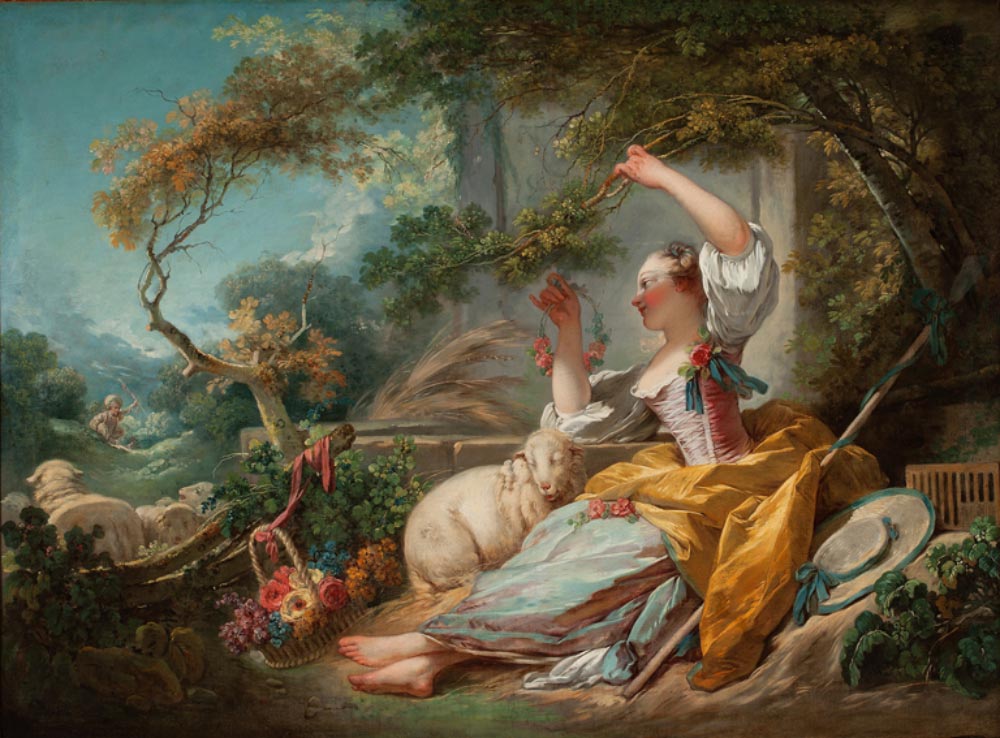In my high school art history class, my teacher, having covered with reverence the high-contrast drama of the Baroque, flipped the slide machine to show Jean-Honoré Fragonard’s The Swing and paused, glaring at the slide in the darkened room. Then she pronounced: “The Rococo. I loathe the Rococo! The Rococo is art history’s porn!”
Admittedly, there’s truth in that statement—artists working in this style often included sexual innuendo in their works (the aforementioned The Swing features a young man looking right up the lady’s skirt; our own The Shepherdess, left, also by Fragonard, is chock full of tongue-in-cheek references—check out Tom Strini’s Third Coast Digest article on this piece for more). And my teacher’s statement reflects the attitude of many an art historian, although they usually phrase it a bit more delicately. The Rococo is not exactly the popular kid of art history periods—its pastel, rounded shapes, pretty, fashionably dressed girls, and general frippery are not fawned over by most art historians, who think they are without substance.
Well, to that I say: Whatever! (Cue rotten tomatoes from said art historians.) Rococo works might not make me think about the fleetingness of life or catapult me to religious epiphany—that’s fine. Sometimes I just need to look at something pretty. I equate it to the occasional milkshake or indulgent shopping trip: you don’t want to overdo it, but every so often, it can just be fun to look at a visually gorgeous, lush, over-the-top Rococo painting like Fragonard’s The Shepherdess, right here in our own Museum.

The Neo-Decorative designers whose work is displayed at the very end of our feature exhibition, European Design Since 1985, would agree with me. They took inspiration from Rococo paintings, and created chairs, plates, light fixtures and other objects that drip with flowers, are covered in sumptuous fabric, or are delicately painted with foliage and petals—like Jurgen Bey’s floral St. Petersburg chair.
Have your own indulgent moment at the Museum: find The Shepherdess in the Gallery 8, and the Bey chair (and much more) in European Design Since 1985, located in the Baker/Rowland Galleries.




6 replies on “From the Collection: Jean-Honoré Fragonard’s “The Shepherdess””
[…] so the next class, after a bit of discussion and word games (we compared Fragonard’s Rococo painting to the Neo-Decorative objects in European Design Since 1985), we got out our gallery stools and […]
[…] I gave gallery talks on his work at the Frick Art & Historical Center in Pittsburgh, PA. Like Jean-Honoré Fragonard, he is not the most respectable artist for an art historian or museum educator to love: his work is […]
[…] soulless, mass-produced, and disingenuous–I thought I’d ignore all the star-crossed and wanton lovers in Museum paintings to point out this great red sofa that seems to embody all the over-the-top love […]
[…] remember my last year of high school at the Milwaukee Art Museum where there is a painting I hated (Fragonard’s The Shepherdess.) My teacher had me spend several hours with it, drawing it, and I fell in love with it. There […]
[…] Museum, the French artist Jean-Honoré Fragonard (1732–1806) is known as a painter. He painted The Shepherdess (pictured below), which is the focal point of our Rococo […]
I know what you mean, having gotten my degree in art history. But if you really look at Fragonard you realize– wow, that guy could really handle paint and paint brush. And he had a wider range than a lot of people realize. I love him to death. Love the two times I got to see the large panels at the Frick. I like Boucher too. I sort of just mentally filter out the sexual, just as I do when watching anything on TV these days. And it’s not all prettiness too, I don’t think. Even with the prettiest, there can be the threads tied to the wistfulness of Watteau, who was probably the biggest transitional figure on the way to Rococo. (Incidentally, I entered my website in the website space but it said “Please enter URL” as if it didn’t know a URL from a hole in the ground. So if anyone is curious, my website is drewthurston.com.)